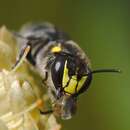pt-BR
nomes no trilho de navegação


Hylaeus alcyoneus, commonly known as the banksia bee, is a bee species endemic to Australia where it is commonly found in the coastal heaths of eastern and southern Western Australia. This bee is an important pollinator of Banksia species.
The banksia bee was originally described by German entomologist Wilhelm Ferdinand Erichson in 1842; its specific epithet is derived from the Ancient Greek halcyon "kingfisher" relating to its kingfisher blue colour.
The banksia bee has a metallic blue abdomen and yellow face markings.[1] The sexual dimorphism of this species is notable amongst bees — the males of the species are significantly larger than the females; in most other types of bee, females are larger than males.[2] Males of different sizes have been shown to display different feeding behaviour. Large males perch and defend Banksia inflorescences that are in high positions on the shrub where they feed; small males feed closer to the ground and patrol circuits including several inflorescences. Displacement of large males from the perches is almost always by an even larger male.[3]
Western Australian banksias which the bee has been recorded visiting include Banksia ashbyi, B. coccinea, B. hookeriana, B. ilicifolia, B. menziesii, B. prionotes, B. sessilis, and B. speciosa. Other species include Allocasuarina campestris, Grevillea cagiana, G. eriostachya, Isopogon dubius, and Xanthorrhoea species.[4]
The Banksia bee faces competition from the introduced European honey bee (Apis mellifera). In sites where the species coexist, the Banksia bee has significantly fewer nests that it has on sites where there is no competition.[5] A banksia bee nest consists of several cavities or cells within hollowed pieces of wood. A parent bee places provisions of pollen and nectar in each cell, along with a single egg.[1]
Hylaeus alcyoneus, commonly known as the banksia bee, is a bee species endemic to Australia where it is commonly found in the coastal heaths of eastern and southern Western Australia. This bee is an important pollinator of Banksia species.
The banksia bee was originally described by German entomologist Wilhelm Ferdinand Erichson in 1842; its specific epithet is derived from the Ancient Greek halcyon "kingfisher" relating to its kingfisher blue colour.
The banksia bee has a metallic blue abdomen and yellow face markings. The sexual dimorphism of this species is notable amongst bees — the males of the species are significantly larger than the females; in most other types of bee, females are larger than males. Males of different sizes have been shown to display different feeding behaviour. Large males perch and defend Banksia inflorescences that are in high positions on the shrub where they feed; small males feed closer to the ground and patrol circuits including several inflorescences. Displacement of large males from the perches is almost always by an even larger male.
Western Australian banksias which the bee has been recorded visiting include Banksia ashbyi, B. coccinea, B. hookeriana, B. ilicifolia, B. menziesii, B. prionotes, B. sessilis, and B. speciosa. Other species include Allocasuarina campestris, Grevillea cagiana, G. eriostachya, Isopogon dubius, and Xanthorrhoea species.
The Banksia bee faces competition from the introduced European honey bee (Apis mellifera). In sites where the species coexist, the Banksia bee has significantly fewer nests that it has on sites where there is no competition. A banksia bee nest consists of several cavities or cells within hollowed pieces of wood. A parent bee places provisions of pollen and nectar in each cell, along with a single egg.
Hylaeus alcyoneus is een vliesvleugelig insect uit de familie Colletidae. De wetenschappelijke naam van de soort is voor het eerst geldig gepubliceerd in 1842 door Erichson.[1]
Bronnen, noten en/of referentiesHylaeus alcyoneus[1][2] är en biart som först beskrevs av Wilhelm Ferdinand Erichson 1842. Den ingår i släktet citronbin och familjen korttungebin.[3][4] Inga underarter finns listade i Catalogue of Life.[3]
Ett övervägande svart bi med en metalliskt blåsvart bakkropp och gula markeringar i ansiktet och på mellankroppen. Arten är tämligen liten; kroppslängden är mellan 11 och 12 mm.[5] Till skillnad från de flesta bin, är hanarna tydligt större än honorna.[6]
Arten besöker olika proteaväxter, framför allt (och i mycket hög grad) banksiasläktet.[5] Arten är också en mycket viktig pollinatör av banksiaväxter.[6] Honorna har gadd, men de är inte särskilt aggressiva.[5] Hanarna har två olika strategier när det gäller att finna honor: Framför allt större hanar mutar in en banksiablomma som sitt revir, och försvarar den energiskt mot andra hanar. De försöker sedan para sig med besökande honor. Andra flyger patrullflykt likt humlehanar längs en bestämd bana, i vilken det ingår flera banksiaväxter.[7]
Honorna bygger larvbon i övergivna insektsgångar i stammar och grenar på olika buskar. Bona konstrueras av en utsöndring från spottkörtlarna, vilken stelnar efter hand.[5] Varje bo innehåller flera larvceller, som innehåller ett ägg vardera, tillsammans med pollen och nektar som föda åt larven.[6]
Hylaeus alcyoneus förekommer i södra Australien (inklusive Tasmanien), främst i de fuktigare kustområdena.[5]
Hylaeus alcyoneus är en biart som först beskrevs av Wilhelm Ferdinand Erichson 1842. Den ingår i släktet citronbin och familjen korttungebin. Inga underarter finns listade i Catalogue of Life.
Hylaeus alcyoneus là một loài Hymenoptera trong họ Colletidae. Loài này được Erichson mô tả khoa học năm 1842.[1]
Hylaeus alcyoneus là một loài Hymenoptera trong họ Colletidae. Loài này được Erichson mô tả khoa học năm 1842.